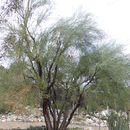pt-BR
nomes no trilho de navegação


Canotia ist eine Pflanzengattung innerhalb der Familie der Spindelbaumgewächse (Celastraceae).[1]
Canotia-Arten sind kahle Bäume oder Sträucher, an den Stämmen stehen dunkle Drüsen. Die Blätter stehen wechselständig und sind zu Schuppenblättern reduziert.
Der Blütenstand ist achselbürtig, sympodial oder thyrsenähnlich. Die Blüten sind zwittrig und fünfzählig, der Diskus fleischig und ringförmig, fünfwinklig oder fünflappig. Die Staubbeutel öffnen sich längs zum Zentrum der Blüte hin, der Fruchtknoten ist fünffächrig, je Fach gibt es zwei bis sechs Samenanlagen.
Die längliche, schnabelförmige und holzige Kapselfrucht öffnet sich längs und entlang der Scheidewände (Septen), je Fach mit einem (selten zwei) Samen. Die Samen sind länglich, abgeflacht und eiweißreich, sie können am Ansatz häutig geflügelt sein.
Die Gattung Canotia wurde 1861 durch John Torrey in Asa Gray: Report on the Colorado River, 4, S. 15 aufgestellt.[2] Typusart ist Canotia holacantha Torr. ex A.Gray
Die Gattung Canotia ist häufig auch anderen Familien zugeordnet worden, so den Rutaceae, Koeberliniaceae oder einer eigenen Familie, den Canotiaceae. Molekulargenetische Untersuchungen bestätigten ihre Platzierung in der Familie Celastraceae; sie gilt als Schwestertaxon zu Acanthothamnus.
Die Gattung Canotia kommt in Mexiko und den südöstlichen USA, in Wüsten vor.
Die Gattung Canotia umfasst nur zwei Arten:[1]
Canotia ist eine Pflanzengattung innerhalb der Familie der Spindelbaumgewächse (Celastraceae).

Canotia holacantha, also known as crucifixion thorn or simply canotia, is a flowering shrub / small tree in the family Celastraceae.[1] It is the only species in the genus Canotia.
The plant is native to the higher elevation deserts of the Southwestern United States in Arizona and southeastern California, and of Northwest Mexico in isolated locales in Baja California and Sonora).[2]
Canotia grows in desert scrub environments, primarily on slopes or in washes. It is found in the higher Sonoran Desert across central Arizona, reaching to the Mojave Desert of California and northwest Arizona, and into the lower reaches of the Grand Canyon.[2]
The prehistoric distribution of Canotia holacantha has been analyzed with pollen records in certain locations. One of the most detailed studies has been conducted in the Waterman Mountains of Arizona, where C. holacantha has been documented to have occurred during the Late Wisconsin glacial period, along with dominant trees Juniperus osteosperma and Pinus monophylla.[3]
Canotia holacantha reaches a height of 10–15 feet (3.0–4.6 m). However, one specimen located in the eastern Mojave Desert near Wikieup, Arizona is known to exceed 30 feet (9.1 m) in height. It is usually a scrubby species, with gray-green branches tipped with sharp thorns.
This species handles photosynthesis with its twigs, rather than the short-lived leaves, like the unrelated Foothill palo verde (Parkinsonia microphylla) which it closely resembles. Its leaves are insignificant scales which are quickly shed and rarely seen; more easily seen are its seed pods, which are persistent clusters of reddish-brown seed capsules which hang in groups of five.
Other common names for this species include chaparro amargosa, corona-de-cristo, and rosario; all such names are in reference to its thorny twigs, which are likened to the Crown of Thorns. The name "crucifixion thorn" is also applied to several unrelated species, some of which canotia shares its range with, including Castela emoryi in the family Simaroubaceae and Koeberlinia spinosa (allthorn) in the family Koeberliniaceae.
The World War II Ailanthus-class net laying ship USS Canotia was named after this tree.
Canotia is grown in cultivation by seeds.
 Canotia aka Crucifixion thorn, Upper Red Rock road, Sedona area. Many of the Central Arizona Canotias are within the Pinyon-juniper woodlands.
Canotia aka Crucifixion thorn, Upper Red Rock road, Sedona area. Many of the Central Arizona Canotias are within the Pinyon-juniper woodlands. Canotia holacantha, also known as crucifixion thorn or simply canotia, is a flowering shrub / small tree in the family Celastraceae. It is the only species in the genus Canotia.
Canotia es un género de plantas con flores con dos especies pertenecientes a la familia Celastraceae.[1]
El género fue descrito por John Torrey y publicado en Reports of explorations and surveys : to ascertain the most practicable and economical route for a railroad from the Mississippi River to the Pacific Ocean, made under the direction of the Secretary of War 4(5): 68. 1857.[2] La especie tipo es: Canotia holacantha
A continuación se brinda un listado de las especies del género Canotia aceptadas hasta octubre de 2013, ordenadas alfabéticamente. Para cada una se indica el nombre binomial seguido del autor, abreviado según las convenciones y usos.
Canotia es un género de plantas con flores con dos especies pertenecientes a la familia Celastraceae.
Canotia Torr. – rodzaj roślin należący do rodziny dławiszowatych (Celastraceae R. Br.). Obejmuje co najmniej 10 gatunków[3] występujących naturalnie w Meksyku i południowo-zachodniej części Stanów Zjednoczonych[4].
Rośnie na pustyniach[4].
Rodzaj należący do rodziny dławiszowatych (Celastraceae R. Br.), rzędu dławiszowców (Celestrales Baskerville), należącego do kladu różowych w obrębie okrytonasiennych[1].
Canotia Torr. – rodzaj roślin należący do rodziny dławiszowatych (Celastraceae R. Br.). Obejmuje co najmniej 10 gatunków występujących naturalnie w Meksyku i południowo-zachodniej części Stanów Zjednoczonych.